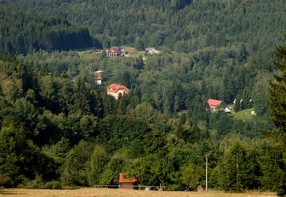HISTORY OF THE VILLAGE
The first written records of the village date back to 1429.
The village of Hamry was founded on the trade path called Železná (Iron) or Bavarian, which led past the saddle of Špičák mountain to the Úhlava valley. It became the seat of one of the greatest communities of free border guards (Králováci). The settlement was then composed of many independent farmsteads spread along the Úhlava and higher up beneath the border ridge. The development of the settlement is due to iron ore processing in the area. The village was named after the iron-mills (hamry) that were processing iron ore exploited in the neighbourhoods. One of the first iron-mills in the whole territory of the Šumava mountains was built in here in 1524-1535. The village itself was founded in 1850 and with its area of 3530 hectares then had 1225 mostly German-speaking inhabitants.
With development of the village also occurred several glass-works and glass-cutting shops or many saw-mills processing timber of the impenetrable Královský hvozd. One of the major glass-works was founded here in the mid 18th century.
The Úhlava river was extremely important for development of this deepest valley of the Šumava mountains. Its water powered iron-mills, mill-wheels and turbines of hydro power plants. Sophisticated water canals - both open and covered - made it possible to take full advantage of water potential in the area.
The company Petzoldt established a paper-mill (manufacturing ground-wood and wood-pulp paper) in Hamry in 1882-1884. The factory operated until late 1980's. Its production was terminated in 1975.
The village was the most populated before the World War II (1450 inhabitants) and the less populated in 1980 (only 102 inhabitants). After 1945, Hamry nearly completely became extinct, similarly as many other villages. After several farmsteads only the buildings foundations or fruit trees have remained. Though Hamry was accessible in the communist era, a part of it laid in the border zone and every car passing through was controlled by the frontier guards. The nearby railway station originally called Hamry-Hojsova Stráž actually dropped the name Hamry off. Fortunately, today everything is the same as it used to be before.
The stretched village has five preserved chapels in vicinity of local former farmsteads as is Knížecí statek, Veitlovský dvorec, Špirkův dvůr, Guberův dvůr or Fenzlův dvůr. The chapels have been restored by today's proprietors of the farms. Along the roads connecting the farmsteads we can see several crosses and wayside columns, as symbols commemorating death of a farmer or a forest worker. The history of the village and the life of people in the past is recalled by the names of the original farmsteads (hofs), as for instance Lenkenhof, Goglhof, Berghof, Modlhof, Stefflhof, Donnerhof, the foundations of which are still visible in the area.
The writer Leo Hans Mally was born in Hamry on 18th July 1901 as a son of the forester, whose family lived at the farmstead Fenzlův dvůr. Th family's timber building dates back from the beginning of the 19th century and served as the forester's house from 1873. The building is still inhabited (land-reg. No. 46). Hans Mally studied German studies in Prague and Munich. He loved both Prague and the Šumava and the majority of his poems as well as prose are linked to these places. Amongst his bet-known works we could name the book of poetry "Prag und die Böhmerwald", the prose "Geschichten um ein Walddorf" and the book "Der alte Böhmerwald – was mann sich damals erzälte" ("The Ancient Šumava - Stories that Used to Be Narrated") - poems and stories of one year passed in the area between the mountains of Ostrý and Javor. The writer died on 16th December 1987 and is buried in the German part of Železná Ruda.
Another notable personality who was living in Hamry since 1920's was the music composer and conductor, Professor Pavel Stuiber, who also died at his piano in his local villa on 20th March 1967. Pavel Stuiber was born on 6th October 1887 in Nepomuk. He studied music and philosophy in Munich and Leipzig, and later acted as a conductor at several opera houses, as a chorus-master in Prague and as a director of the German school of music in Liberec. He composed several chamber compositions, sonatas, concertos and songs. Some of them were broadcast by the radio of Pilsen after 1945. He built his villas in vicinity of the railway station Hamry-Hojsova Stráž. Together with the landscape planner N. Materna he founded at the lands of three hectares a botanical garden with an arboretum that naturally integrated into the surrounding landscape. He collected there many rare floral and wood species, including flowering rhododendrons, yuccas, foxgloves and other unusual species imported from China, Afghanistan, Turkestan, the Caucasus, and South America that were enticing many visitors and tourists. Pavel Stuiber was a nice and modest man, who loved music, nature, Hamry and the whole Šumava mountains. After his death the garden shared the same destiny as many other places in the region - became lonesome and desolate.

